Pointers are a breed of gun dog that has been used for centuries to help hunters locate and point out fallen game birds, like duck and quail, which is something they share in common with breeds like the Irish Setter.
They’re not just great hunters, though. They also make loyal, intelligent, and obedient family companions that don’t shed much hair and are pretty easy to groom.
However, there is more than one type of pointing dog, and each variation has its own shedding and grooming profile. So in this article, we’ll be taking a look at some of the most common types of Pointers to give you an idea of how much shedding to expect from each.
Recommended: Go here to see our top-rated dog hair blow dryers
Pointer Shedding – All You Need to Know
Here are some of the most common types of Pointer:
- Pointer (AKA English pointer)
- German Shorthaired Pointer
- German Longhaired Pointer
- German Wirehaired Pointer
- Portuguese Pointer
- Small Munsterlander Pointer
- Pudelpointer
There are other types of Pointer, but these are the ones listed on the AKC website, and they seem to be the most popular. So these are the ones we are going to be focussing on.
Pointer (AKA English Pointer)

The Pointer is a loyal, obedient dog that stands up to 28 inches tall and weighs up to 75 pounds. They make excellent family companions and hunting companions alike.
They are sometimes referred to as “English Pointer,” possibly because the first Pointer appeared in England in the mid-1600s. However, the AKC refers to them as “Pointer.”
- Coat: The Pointer’s coat is short, smooth and glossy. It comes in a variety of colors including mixtures of black, white, lemon, orange and liver.
- Shedding: The Pointer is a low shedding breed. They shed a small amount of hair year round, which is very manageable with brushing.
- Grooming: Maintaining the Pointer’s short coat is fairly easy, a quick brush once per week with a bristle brush or rubber hand mitt is all they need.
English Pointers (or just Pointers) is one of the lowest shedding Pointers of all, not to mention one of the easiest to groom. So if you’re looking for a low shedding, low maintenance Pointer, this is the one.
German Shorthaired Pointer
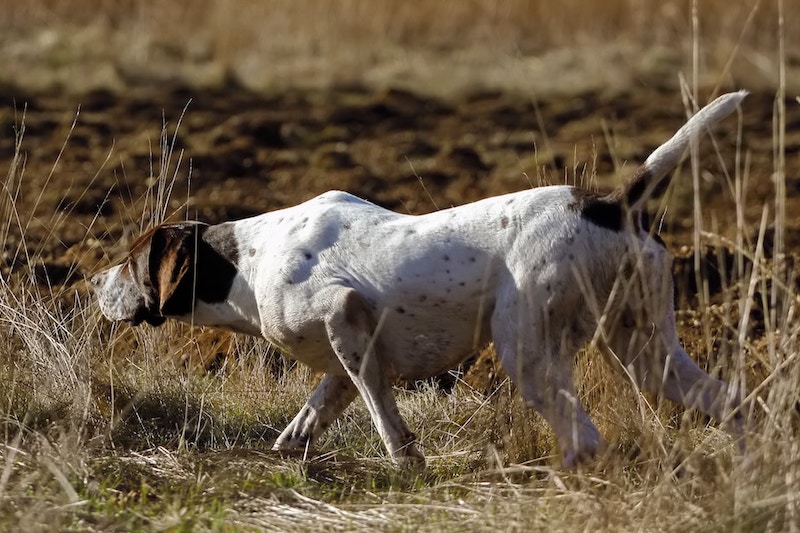
German Shorthaired Pointers (GSPs) are intelligent, loyal, obedient dogs bred as hunting companions in Germany in the late 1800s. They’re similar in appearance to English Pointers, just not quite as big. They stand up to 25 inches tall and weigh up to 70 pounds.
GSPs were born to hunt and, while they’re commonly referred to as “bird dogs,” they are known to be skilled hunters of other animals. They also make excellent swimmers, rivaling breeds like the Newfoundland and Golden Retriever in this respect.
- Coat: The GSPs water resistant coat is short, thick and coarse to the touch. It comes in variations of black, black roan, white, liver, and liver roan.
- Shedding: German Shorthaired Pointers are on the low end of moderate shedding breeds. They shed year round, but also shed seasonally, which means he loses more hair during seasons like spring and fall.
- Grooming: Grooming your GSPs coat is simple because it’s so short, brushing once per week with a bristle brush or rubber brush should do the trick.
See our complete GSP shedding guide to learn more.
German Longhaired Pointer
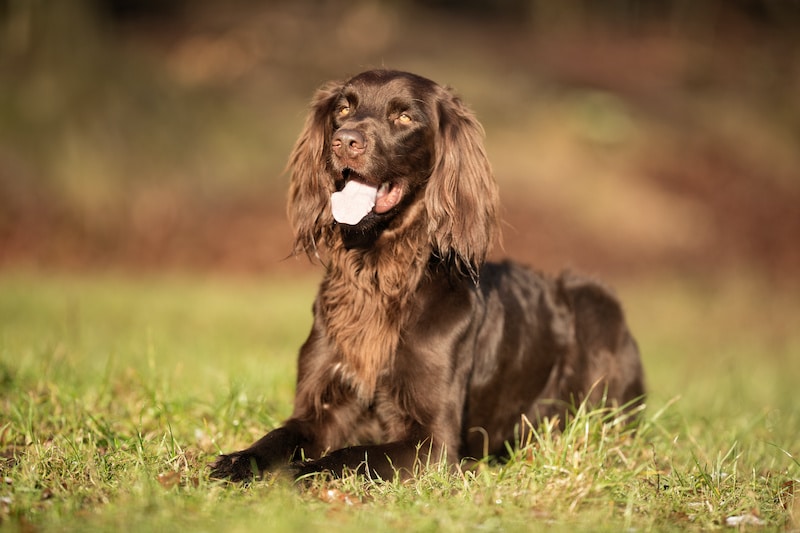
The German Longhaired Pointer is, as the name suggests, a longer-haired version of the Shorthaired Pointer. But he has a unique personality and is larger, standing up to 28 inches at the withers and weighing up to 80 pounds.
- Coat: German Longhairs are double coated. Their outer coat is made up of long brown or white hair, and their thick undercoat protects them from harsh weather conditions.
- Shedding: Longhairs shed about the same as Shorthairs year round, but they blow coat a couple times per year. So, overall, they are a moderate shedding breed.
- Grooming: Brushing your Longhair will take more effort than a Shorthair, because their coat is longer. They are prone to mats and tangles, so regular brushing is needed to maintain their coat and limit shedding.
German Wirehaired Pointer

German Wirehaired Pointers are a bit taller than a GSP, standing up to 26 inches tall and weighing up to 70 pounds. And their coat is wiry, which suits them as an all-around hunting dog.
Their weatherproof double coat keeps them warm in the water and protected in harsh, thorny bushland. Not to mention, they’re very energetic so need lots of stimulation.
- Coat: Wirehaired Pointers have a rough, wiry top coat that is about one to two inches in length. And a thick undercoat that insulates them in cold and warm weather alike. The colors of his coat can be liver, liver and white, or black and white.
- Shedding: Wirehairs shed a moderate amount of hair year round, about the same as you’d expect from a Longhaired Pointer.
- Grooming: Maintaining your GWPs coat is fairly straightforward, but will take more effort than a Shorthaired Pointer. A brush once or twice per week with a slicker brush should do the trick though.
Portuguese Pointer
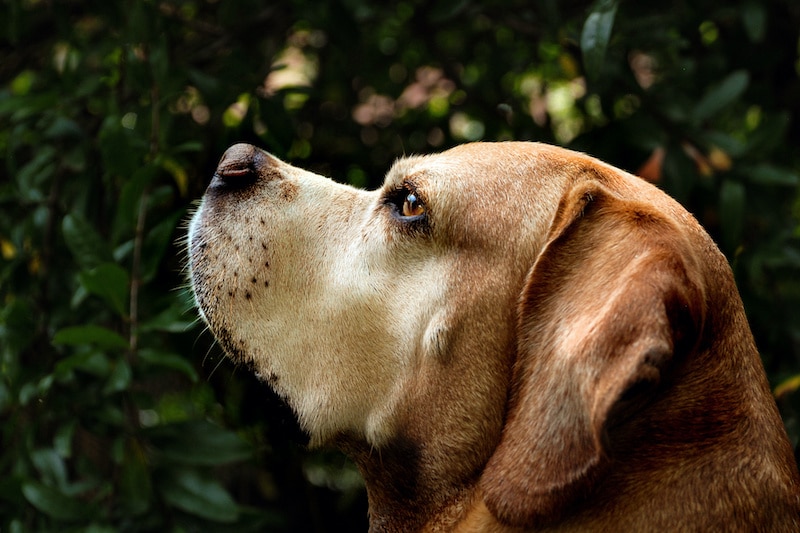
The Portuguese Pointer is a medium breed that originates from Portugal. Like most Pointers, they excel at hunting and love sports. However, they aren’t quite as popular and differ in size, standing up to 22 inches tall and weighing up to 59 pounds.
- Coat: Portuguese Pointers have short coats that come in shades of yellow and red, with white markings.
- Shedding: These Pointers are considered low shedding, they do shed a little bit throughout the year, but it’s not very noticeable.
- Grooming: The coat of a Portuguese Pointer is easy to maintain, brushing once per week with a bristle or rubber brush will remove any shed hairs and keep their coat looking great.
Small Munsterlander Pointer
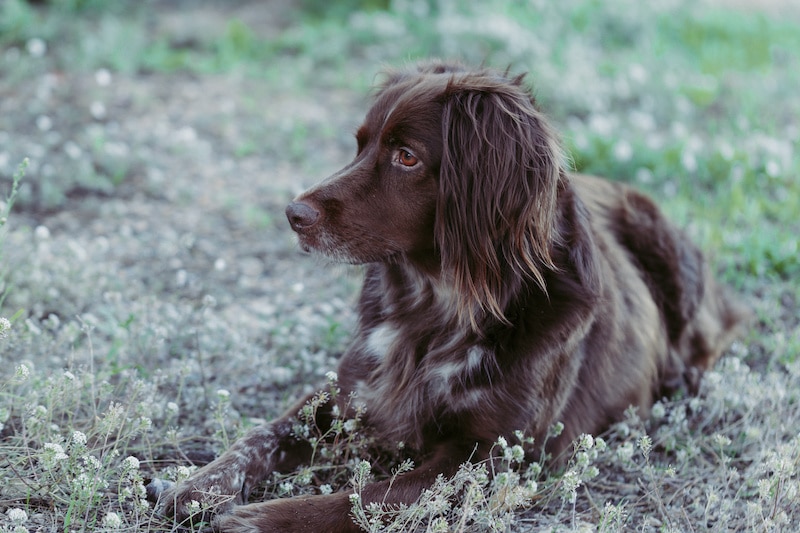
Small Munsterlander Pointers are, despite their name, medium-sized dogs that stand up to 21 inches at the withers and weigh up to 60 pounds. They make friendly, devoted family dogs and versatile hunters.
- Coat: The Munsterlander Pointer’s medium length coat comes in brown and white and brown roan. And the texture is straight, glossy and dense.
- Shedding: Small Munsterlanders shed moderately throughout most of the year, and heavier during spring and autumn. So overall these aren’t the lowest shedding type of Pointer.
- Grooming: Maintaining your Munsterlander’s coat isn’t difficult. But because their coat is longer than a Shorthaired Pointer, they will require regular brushing with a slicker or pin brush to maintain their coat, keep it mat free, and remove the loose fur from their coat.
Pudelpointer

Pudelpointers are a German breed that is the result of mixing a Poodle with a Pointer. They’re about the same build as a Wirehaired Pointer, and their coat is similar too.
- Coat: The Pudelpointer has a beautiful double coat that comes in wiry, rough and short varieties and is either black or liver in color.
- Shedding: Given that Pudelpointer are crossed with two low shedding breeds, they are low shedding. However, they do have a dense undercoat and shed seasonally, which means they are not a hypoallergenic breed.
- Grooming: As with most Pointers, grooming is quite easy. Depending on the variation in top coat of your Pudelpointer, brushing with a slicker or bristle brush once per week is enough. Although more regular brushing can help during shedding season.
Recommended: Go here to see our top-rated dog hair blow dryers
How to Stop Your Pointer from Shedding Excessively
You can’t stop a Pointer (or any dog) from shedding completely, it’s something that almost all dogs do, and it’s perfectly natural. But the good news is, you can significantly reduce it.
And one of the simplest and best methods of reducing Pointer shedding is by brushing them regularly. Brushing removes the dead fur and can potentially save you a lot of time vacuuming and cleaning hair off of your clothes and furniture.
It also helps to keep their coat in good condition. Because when you brush, it helps to spread the oils of the coat, which can promote a healthier coat that ultimately loses less fur.
Related: Does Coconut Oil Reduce Dog Shedding?
Bathing is another great way to minimize shedding, or at least how much of what they shed falls off of them. A good bath once or twice per month, depending on which type of Pointer you have, can help to remove any old fur and loosen it up before brushing.
This is especially helpful during heavy periods of seasonal shedding. Just be sure to use a good dog shampoo and avoid over bathing, as either of these have been known to dry out their skin and hair, which can make shedding worse.
Aside from bathing and brushing your Pointer, making sure he is eating quality dog food can make a big difference as diet plays a role in how healthy their coat is, which impacts shedding.
These shedding tips might sound overly simple, but they work to reduce excessive shedding as long as you are consistent, especially when it comes to brushing. The more effort you put into brushing your Pointer, the less time you’ll spend cleaning up the aftermath. Thankfully, Pointers aren’t heavy shedders anyway, and their coat is straightforward to maintain.
Sometimes dogs can shed for reasons beyond what is considered “normal,” though. So, while normal shedding in some breeds can be pretty high, if you’re concerned it’s excessive, it might be worth contacting your local vet.
Recommended: Go here to see our top-rated dog hair blow dryers
Related Questions
Are Pointers Hypoallergenic?
No, Pointers are not hypoallergenic. They don’t shed much, but that doesn’t make them hypoallergenic because their hair isn’t what causes dog-related allergies. Instead, it’s the dog’s dander (or dead skin), urine, and saliva, which every dog produces to varying degrees, even hairless breeds.
This is why it’s controversial even to use the term hypoallergenic, to begin with, because no dog is 100% perfect for people who suffer from allergies.
It’s just that some breeds, like the Italian Greyhound, for example, are considered hypoallergenic (mostly) because they shed very little. And therefore, allergens like dander and dried saliva that attach themselves to their fur don’t fill your home as much.
Either way, Pointers are not considered hypoallergenic.
What Does Seasonal Shedding Mean?
Seasonal shedding refers to a period of time each year when dogs shed more heavily than usual. This occurs typically during spring and fall (autumn) for about 2-4 weeks.
It’s perfectly normal for this to happen, but this can be pretty extreme and somewhat sudden. And is especially noticeable in dogs with a thick double coat (topcoat and undercoat).
All that is happening is they are shedding their winter coat in late spring because they don’t need this during summer. And they’re shedding their summer coat in the fall to make way for their winter coat that will keep them warmer during the colder months. So make sure that you have your brush and vacuum cleaner ready during this time because you’ll be needing them.
Which Brush is Best for a Pointer?
The best type of brush for a Pointer (AKA English Pointer) is a bristle brush or rubber hand mitt because these are well suited to dogs with short, smooth coats. However, the slicker brush is better suited to variations such as the Longhaired or Wirehaired Pointer as these are better for removing mats and dead hair in longer-haired breeds.
You could also use a metal comb or de-shedding tool because these do a great job of getting rid of the loose undercoat fur that some of the Pointer breed variants have.
If you want to compare the different types of dog shedding brushes and find out which one is best for every kind of coat, check out our top-rated dog shedding brushes.
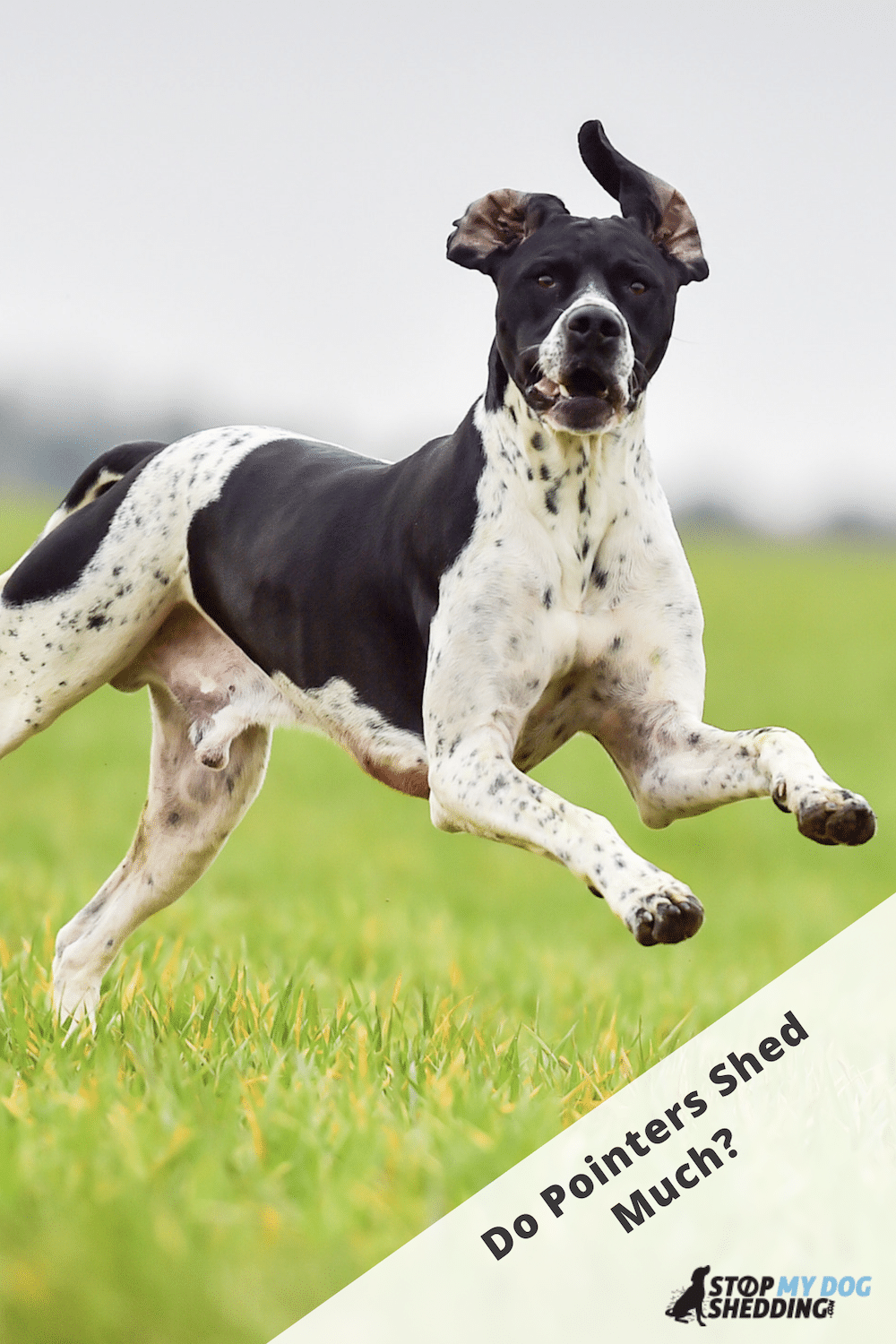

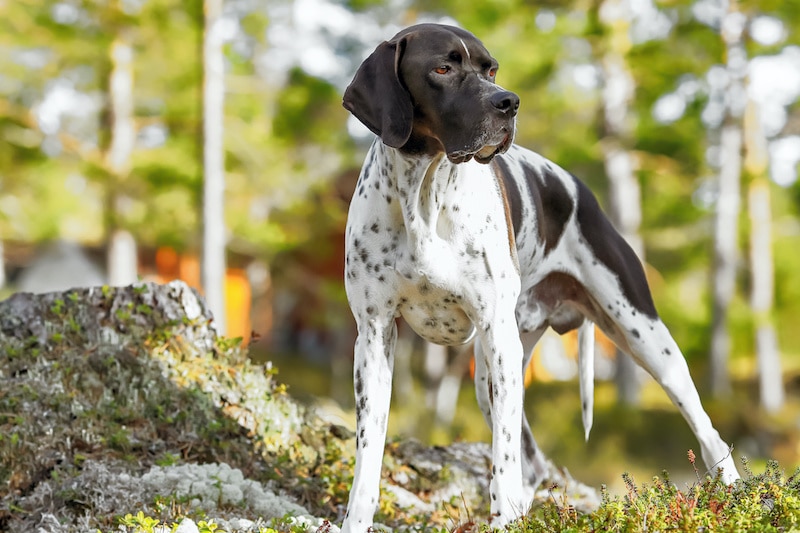










Please note: By submitting a comment using the above comment form, you confirm that you agree with the storage and handling of your data by this site as detailed in our Privacy Policy.